One August morning in 2015, HSBC workers arrived on a seemingly normal Friday; but normal it was not. Soon the phones started ringing: “None of our 150 staff have been paid, which before a long weekend, is a disaster”.
It was just the start of a huge service outage where 275,000 individual payments failed, leaving, potentially hundreds of thousands of people without their pay on the Friday before the bank holiday weekend!
While you will, hopefully, never have to deal with such an enormous service failure, service failures happen in your business. So service recovery is something that you need to know how to do and do well. Turning around unhappy customers is just too important to ignore. But, it’s a big subject and making it work can be difficult.

What is Service Recovery
Let’s start with a simple definition:
Service recovery is the process by which organizations react to and recover from a poor customer experience. Initiation of service recovery typically originates from direct customer complaints, social media messages, customer surveys and employee insights.
Why do you do it?
Because we want the universe to continue in heavenly balance to improve the profitability and longevity of our business.
There is nothing mystical about why you’re performing this process. It adds value to the business; pure and simple.
In summary this value is driven by:
- The, generally, accepted wisdom that keeping a customer is cheaper than finding a new one
- The fact that happy customers buy more
- The reduction in costs achieved when business processes are improved through the information uncovered in correcting service breakdowns.
As an example of how much value can be generated for a business Moshe Davidow demonstrated a 177% ROI on complaint handling when he set up and ran Israel’s first modern customer service department.
Several of our clients have calculated the value in retained customers and increased revenue and shown that it more than outweighs the cost of making the contact.
Looks look at that value in more detail.
Keeping Customers Longer
Service recovery is what I call a retail approach. You fix each customer issue to keep that particular customer. This is not the most efficient process but it does work and drives value in and of itself.
Importantly, research shows that customer perception of the process is a driver of customer retention. A fast, efficient and effective service recovery process directly drives customer perception of the service recovery process and future sales.
You can also see from this survey by Temkin Group showing a good recovery process increases revenue and a poor one, decreases revenue.
![Service Recovery Drives Revenue [Source]](https://www.genroe.com/wp-content/uploads/Value-of-Service-Recovery.jpg)
So, a well executed service recovery will keep a customer at the time of the issue and afterwards. A poorly executed process may not keep them at all.
In addition, subject to a few caveats, the Service Recovery Paradox means you will probably keep that customer longer than normal into the future.
So you have a double value for the process: keeping this customer now and longer into the future.
Calculate how much business are you already losing
You can easily estimate your loss of business from unmanaged complaints with this calculation:
Customers Lost = Number of Complaints x 25 x 46%
Revenue Lost = Customers Lost x Average Customer Revenue
The “25” above comes from the common finding that only 4% of unhappy customers complain (see later in this article).
The 46% comes from the table below, showing 46% of complainants react by ceasing to do business with your company.
Go ahead and do a back of the envelope calculation for your business right now to determine the value that you’re directly losing by not handling complaints.
Reducing Negative Word of Mouth
Still not convinced? Have a look at all the ways that complainants express, and share, their displeasure.
Top of the list: tell their story to friends and family. Third, never do business with you again.
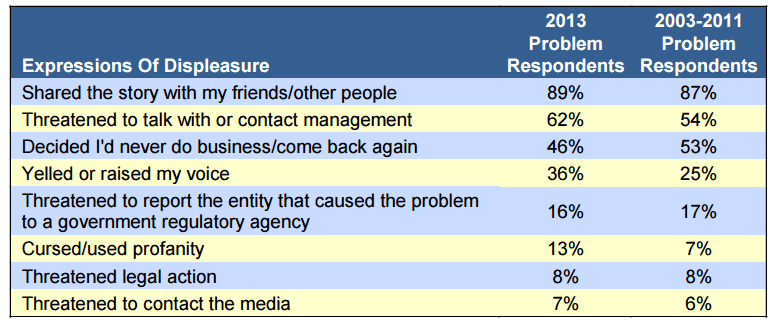
And remember social media is an amplifier of word of mouth. United Airlines found out the hard way when one unhappy customer put his complaint into song and received more than 15 million youtube hits.
Lower Business Costs
But fixing the current complaint is not the end of the value. Rolling up the complaint data and pushing it into your continuous improvement process can lower costs long term as you improve your business processes.
Lower costs come from handling fewer complaints, reducing the “re-work” of fixing complaints and improving business processes so they never happen in the first place. A triple benefit.
It Keeps You Off TV and Out of the Courts
The 24hr news cycle, “investigative journalism” and the litigious nature of society means that any complaint or ill feeling can have you ending in the consumer reports section of your local news broadcast. Or worse; facing litigation.
In the above study, 15% of people threatened to go to the media or their lawyers. Sure many of these are idle threats but even if only a few percent do, the organisational cost of managing a full blown PR emergency is very high.
Employees Value it as Well
Interestingly, employee perceptions of the organisation partly reflect how it handles the service recovery process. Research shows that effective service recovery leads to higher employee job satisfaction and lower intentions to quit. [Source]
Also there is substantial evidence that links employee and customer attitudes and indicates that employee attitudes can “spill over” to customers. [Source] Put simply, unhappy employees take it out on customers.
Sources of Recovery “Leads”
The starting point for any recovery process must be a dissatisfied customer or poorly delivered process. I’ll call them “leads” in the sense that they are opportunities to turn around customer perceptions of the organization.
Complaints
Complaints are the starting point most people think of first as recovery leads.
The issue is that only a very small proportion of unhappy customers actually complain so you will only capture a very small number of unhappy customers. There are plenty of different research papers on the topic and they all provide similar numbers.
Only about 1 in 25 unhappy customers will formally complain to an organisation — and 46% of the others will simply leave silently (see earlier).
So, while you absolutely should be filling the recovery funnel using your complaints system, it should not be your only source.
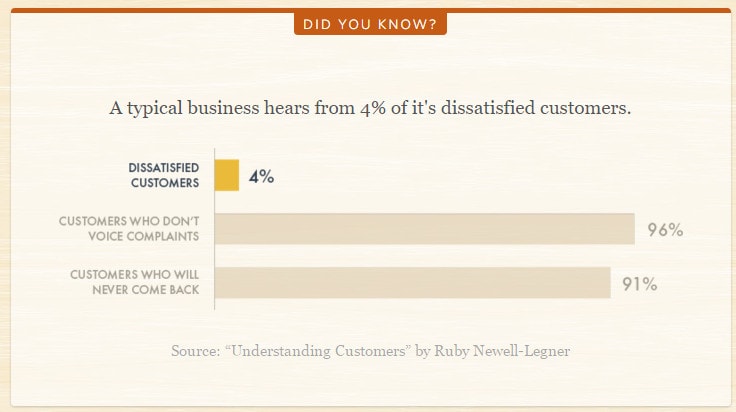
Social Media Listening
While complainers may not talk to you, you can bet they are talking to their friends and probably by facebook, twitter, etc.
Particularly if you business is consumer focused you need to be listening to social media to pick-up negative mentions of your business and brand and correct them quickly. While all customers want quick responses to their problems, people who post problems publicly want them resolved double quick: 39% expect a response in one hour.
There are plenty of social media monitoring tools that you can use to be alerted to issues. So make sure you invest the time in setting one up as an input to your process.
As a side-note: typically people only go to social media to publicly out a company after they have tried all the normal forms of obtaining a satisfactory outcome. This also means that they are likely to be more frustrated and angry than the average complainer.
Self Identification
Sometimes you will uncover service failures in your business that need to be rectified. In some cases, customers will not even be aware of the service failure so you have the opportunity to lift the level of trust customers have in your organisation.
For example, recently an Australian bank uncovered overcharges in their credit card business.
In this case the bank pro-actively contacted the relevant government oversight group and customers to refund the excess fees.
This type of proactive redressing of issues supports customer trust in the organisation. The more customers trust a company the more they will use and recommend the company.
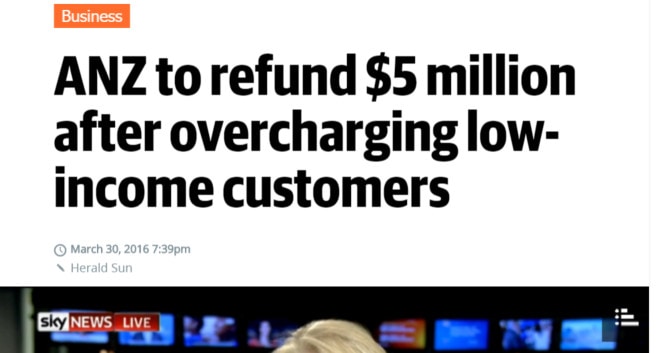
Customer Feedback
The last major source of recovery leads is your customer feedback process, particularly if you are running a transactional survey process.
Every low score should be pushed into the service recovery system for action because evidence shows that a quick and effective resolution process built on the back of the survey process can lift your Net Promoter Score by 11 points.
When you start service recovery using this source of leads, do so only for the lowest scores (0’s for a Net Promoter Survey), test and learn, then move the score at which you take action up to 1 then 2, etc.
Then, when you are happy with the process, you can add a “please contact me” tick box to the survey. Customers who specifically want help can use it to “raise their hand”.
Don’t add this box when you’re just starting out because it raises customer expectations of a return contact. If you have not ironed the bugs out of the process you will not be confident that you can meet those raised expectations.
The “please contact me” box has the bonus of also gathering up-sell leads because many high scorers will use it to request new products and services from you.
What Do Customers Want
You might think a refund or compensation was the top requirement but have a look at this list of what complainants wanted and what do you see?
They mostly just want to be treated with respect, and have the issue corrected. Refunds and free services are a long way down the list — 10th to be precise.
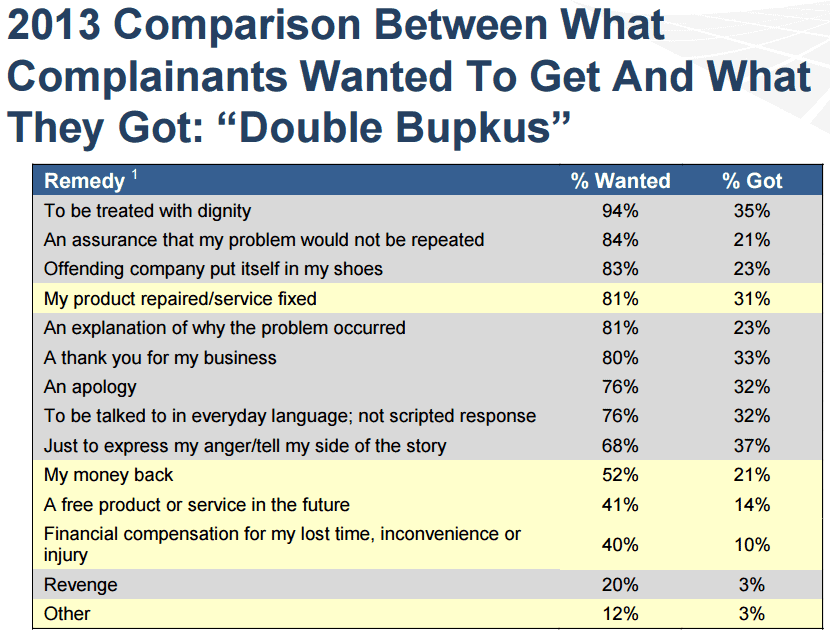
So don’t look at this as simply refunding customer’s payments. Half don’t want it and for the half that do, other softer elements are more important.
Additional research (The A-Craft Model of Organizational Responses to Customer Complaints and Their Impact on Post-Complaint Customer Behaviour) reinforces that compensation is only part of the story and customers must also feel they are receiving “procedural justice”:
[Procedural Justice just means that customer feels the process was fair to them. They would mark this question with a high rating: “I feel the guidelines used by the company to process my complaint were fair.”]It has long been assumed that compensation is the dominant force behind complainer’s satisfaction levels. This research suggests that while a certain level of redress is important, it is a necessary but not a sufficient condition for satisfaction and favorable post-complaint customer responses. Procedural justice appears to be the prime motivator of word of mouth activity.
What Should You Deliver
Recently, the idea of “wowing” a customer with your service recovery has become very popular. See this post on Zappos service for some examples.
However, the science doesn’t support this as the most cost effective approach. This research showed that the difference in customer loyalty outcomes for a so called “high service recovery” and “medium service recovery” outcome were about the same.
Their conclusion was:
…managers may not experience increased levels of customer satisfaction and purchase intent by spending resources (e.g., money and time) above those that result in moderate service recoveries. In sum, ‘‘more’’ (recovery effort) may not always be ‘‘more valuable.’’ There may be a recovery threshold, per se, whereby recoveries over and above this level go unnoticed or unrewarded by the customer. [Service recovery’s influence on consumer satisfaction, positive word-of-mouth, and purchase intention]
So you certainly need to resolve the issue but be careful that you don’t stray into the realms of marginal incremental return on investment.
The Overall Process
Quick and decisive action is not only valued by customers but it will also lower your costs of running the service recovery process. So focus on executing quickly and effectively.
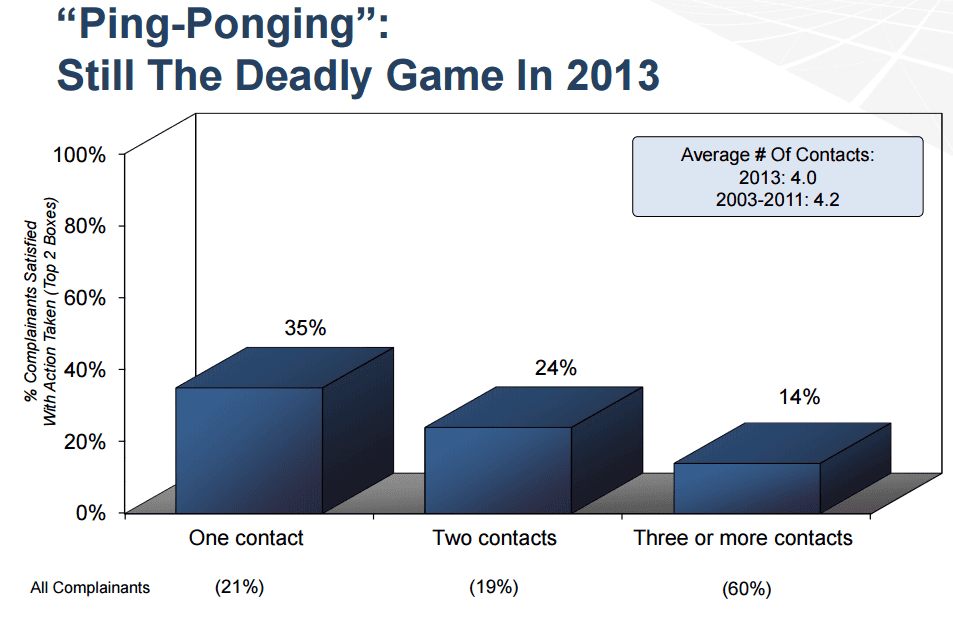
Triage or Direct Action?
At a high level there are two ways you can run the process.
Triage Based
The triage approach works much like triage in a hospital situation. One person receives all of the service recovery “leads” and forwards them to the correct person in the organization to resolve with the end customer.
While this means that every request needs to be handled by one central person, it also means that nothing falls through the cracks and the most urgent/important issues are resolved first.
Direct Action Based
In this approach the recovery request is sent automatically to the correct person in the organization to action.
This assumes you have a clearly defined matrix of issues and organisational roles, along with a system to distribute the requests accurately.
Which is Best?
The best practice for your business will depend but most businesses are better using the Triage process in the early days. Initially the organization will have little information on the types of issues to be resolved and the actions needed to resolve those issues.
Triaging allows the organization the time to learn the best approaches and resolutions. When that learning has been completed and you have fine tuned your processes, move to the direct action approach.
Increasing employees are being encouraged to “think big” and take on responsibility to solve issues. This can mean staff in the triage process have broader authorities and are able to resolve issues quickly. This improves overall speed.
Elements of a Good Service Recovery Contact
A good contact does not have to be complex. It starts with simply calling the customer.
Who Should Call
While it seems like a good idea for the person who assisted the customer in the first place to call them back it rarely is. In the case of a complaint or low customer feedback score the staff member is likely to be defensive in such a situation.
It is much better to have the call made by a team leader or person in a parallel role.
When to Call
This depends a little on the source of the service recovery lead:
Social media: you should should try to contact people within an hour.
NPS or Customer Feedback Survey: faster is better and we have clients who have a 2 hour customer contact KPI for low feedback scores but anything within 24 hours is going to be well received.
Complaints: Will be similar to the customer survey feedback noted above: 2 hours out to 24 hours would be a good time frame.
What To Expect From the Call
Contrary to what you might expect the call is often likely to be a positive experience for the staff member making the call. The customer will be mildly to very surprised that anyone is even contacting them about their issue and will be positively engaged in the initial resolution process.
Janine Scott from Wolters Kluwer Asia Pacific found just this when she started making service recovery calls initiated by their NPS survey. Check out the video below for her personal account of the process.
That being said, there can be negative emotion felt, and expressed, by customers during the call. So it is important that whomever makes the calls is trained not take the issues personally.
The customer has an issue that needs to be addressed and getting defensive, or worse still, attacking the customer during the call is not, clearly, helpful.
You may have to remind the staff member that it’s not about them… it’s about their customers and the experience they had.
It’s Not Me It’s You – Customers at Fault
I’m sure you’ve heard the apocryphal story of the help desk support person who finally discovers the reason the customer’s screen is black is that they have not plugged in it into the power.
While that exact story may not be true, increasing levels of customer self service mean that service failure can often be caused by your customer.
Research indicates that about one-third of all service problems are caused by the customer. As companies increasingly shift work to customers and incorporate more self-service technologies, customers will take on even greater responsibility for service quality. As a result, their failures will become more critical. [How to Prevent Your Customers From Failing]
However, this doesn’t let you off the hook. If it’s the customers fault it is just as important (maybe more) to collect, analyse and action the reasons for the failure. The reasons are twofold:
- Customers are unlikely to attribute much of the blame to themselves and it will still be your problem/fault: “If I made a mistake, it was your systems that allowed me to make that mistake”.
- The costs of correction dramatically reduce the costs saved through the self service functions.
Lastly, if you get this type of service recovery right you can create a customer for life:
The theatregoer who forgets his ticket will long be grateful if the usher slips him in. The service experiences customers rave about most are those in which they were at fault but the company responded anyway. [The Profitable Art of Service Recovery]
The Service Recovery Task
The actual task is not that complex. One powerful framework is Micah Solomon’s 5 part process, which he lightheartedly points out “spells” ARFFD in this article: Four Steps to Great Service Recoveries.
Below are Micah’s steps with some commentary from me:
1. (A)pologize and ask for forgiveness
Make sure the apology is genuine and given with empathy for the client’s position.
This takes the initial confrontation out of the discussion. If you need to, let the customer vent a little as well, but don’t let it become a general complaint session.
Getting the apology right is important and there is a right way to do it. Check out this recent research, Six elements of an effective apology, according to science, for all the details but here are the six important elements.
1. Expression of regret
2. Explanation of what went wrong
3. Acknowledgement of responsibility
4. Declaration of repentance
5. Offer of repair
6. Request for forgiveness
Sometimes an organisation’s legal staff recommend against an apology. If this is the case in your organisation, push back and find some middle ground.
The apology is an important emotional defusing elements in the process. Without it the entire service recovery process is more difficult. An apology is NOT an admission of guilt in the customer’s eyes, it just shows empathy
2 . (R)eview the complaint with your customer
Some active listening is needed at this stage to ensure the staff member understands the underlying issue and what the customer believes needs to be done to correct it.
You also need to ensure that you understand what the customer is not saying. Don’t assume you know what they want or the level of resolution they are expecting.
3. (F)ix the problem and then (F)ollow up
Seems simple enough and it generally is. If the problem can be fixed immediately do so and let the customer know.
If it can’t be fixed on the spot then you need to plan communications to the customers while you are solving the problem. This is where many organisations go wrong: they don’t communicate progress.
The person fixing the problem knows that progress is being made but the customer doesn’t. If the customer hears nothing they assume nothing is happening and that just makes them more angry and upset.
I can’t stress this element enough. Even if the problem is not solved you need to check in regularly (regularly depends on the situation) to say “it’s not solved yet but I’ve done x, y and z to progress the issue.”
Part of this process is explaining what happened and why it will not happen again. Customers generally accept that mistakes do happen — no person or company is perfect. However, they don’t want to see the same mistake repeated in future.
4. (D)ocument the problem in detail
At the end of the process you should document what went wrong and how it was fixed so you can use it in the continuous improvement part of the process.
This is a critical element.

Learning from failures may be more important than simply recovering individual customers, because process improvements that influence customer satisfaction represent the most significant means of creating bottom-line impacts through recovery [Source]
Try to identify the root cause of the service failure and put in place measures to stop it happening again.
Tools like 5 Whys root cause analysis are excellent for getting to the bottom of these business root causes and resolving them long term
Root Cause Analysis Resources
Introductory video on the 5 Whys process:
How Report The Process
Now that your process is running smoothly you should start reporting on it to:
- To track improvement in the process
- Validate the value generated by the process.
The second item is critical: many service recovery programs (and customer retention programs) have been cancelled because no one bothered to demonstrate to management the net value the program generated.
Then, when the inevitable next wave of cost cutting goes through, the program is cancelled because it looks like a cost with no revenue upside. I’ve seen this happen. Don’t let it happen to your program.
Defining Report Variables
Before you report you’ll need to agree some definitions with your colleagues in the organisation.
Case Open
What exactly does case opening mean and when does it happen.
Case Closed
You’ll find that this is not as obvious as you might initially think.
For instance there will be instances in which you can’t fix the customer issue and so closing the case means you’ve simply explained that situation to them in detail.
Resolution Codes
When closing a case you should assign a resolution code that serves to tag that case with the type of problem so you can analyse the different types of issues customer face.
The problem is that Resolution Codes are like Tribbles – initially they seem like a great idea but they multiply at an alarming rate until you’re overrun and have no where to turn.
The secret is not to over think the process initially and then review the codes before they get out of hand.
So at first just assign resolution codes that make sense at the time. Then when you have 50 or 100 cases closed go back through all the codes and group them together into themes. Rewrite the codes using the themes and use those codes. Resist the temptation to add new codes unless absolutely necessary.
Source
Where did the initial trigger for the case come from: complaint, customer feedback, other?
Type Code
In order to drive your continuous improvement process you should tag every with case an issue “Type”. This will be used in your reporting to identify high cost issue or those that repeat on an ongoing basis.
If possible Type codes should be process related, e.g. “document x submission”.
Use a similar process to the Resolution codes to create your Type code list.
What You Should Report + Goals
Your reporting should track the following values:
Number of cases opened by source
Goals: lower is not necessary better. You don’t want to artificially suppress case volumes or complaints. You want to gather them all in so you can action them appropriately.
Rather than rewarding employees to recover, traditional service quality reward systems actually impede recovery by rewarding low complaint rates, which are assumed to indicate high customer satisfaction. In response, frontline employees become tempted to send dissatisfied customers away instead of admitting a failure has occurred [Source]
Time to first customer contact
Remember your first customer contact does not need to resolve the issue. If you can, that’s great. If you can’t you need to let them know what is happening.
Goals: shorter is better — how about starting with 24 hours from initial receipt?
Number of cases resolved by source and Resolution Code
Goals: higher is better. Realistically you should aim to resolve a high proportion of cases but resolving them all is unrealistic.
Time to resolve cases
This can be complex because you will have a few cases that take a long time to close. So you should use a statistic like: Average Time to Resolve Shortest 90% of cases.
You should also report First Call Resolution (FCR) rates. Getting an issue resolved in the first call is a big driver of customer loyalty so you should be looking to close as many as possible this way.
Goal: Start with a goal that is initially achievable for your organization but remember that faster is generally better.
Value of a Closed Case
Remembering that one of the purposes of the service recovery process is generating happier customers, you should try to estimate and report on the value of an average closed case.
Several of our clients have estimated this value and found that it is higher than the cost of the case closing process which, of course, generates incentive to support the recovery process.
Case Type reporting: Frequency, number and resources to resolve
Goals: The goal of this report is to understand which types of case are happening most often and costs the most in resources to resolve.
Use this information you can prioritise your continuous improvement processes: target the most common and most costly failure types first.
Average Cost of a Closed Case
Goal: The cost of a closed case should be as low as possible but not so low that it impacts on the customer’s perception of the organisation.
This is a balancing act and there is no absolute correct answer but you do need to track the cost of closing a case in time and/or investment (refunds, rework, etc)
Return On Investment
Goal: Higher is better
At the end of the day the goal is to improve the business value through an efficient and effective service recovery process so including the ROI of the process is an important task for the organisation. As noted earlier, if you can’t prove the value of the process it will be shutdown in the next management re-organisation.
Technology Requirements
As you can see there are quite a few moving parts to any service recovery process and process automation can help you coordinate those parts.
If you Google ‘service recovery software” you’ll find they don’t really exist. However, you can use the elements of the many, many, support management systems and help-desk systems to run your service recovery process.
The list is almost endless with tools like Freshdesk, Zendesk, Zoho, Salesforce.com Service Cloud, Microsoft Dynamics CRM and others all providing they types of features you need.
This post would be double the length if I tried to review all the systems mentioned here — so I’ll leave that for another time. In the meantime here’s a link to get you started: Compare Customer Service & Support Software.
Thank you
Thanks for the following people for providing some great suggestions for content to include in this post: Arie Goldshlager, Shep Hyken, Micah Solomon, Sam Klaidman, Fred Van Bennekom, Annette Gleneicki, Moshe Davidow.











